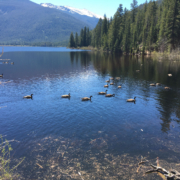Water Data and Science Committee Webinar–November 18, 2021–Dr. Chris Konrad–USGS Streamflow Gaging Network Gap Analysis
Recording of Webinar can be found here: https://youtu.be/ZEbRpqrvW1o
- Call to Order—Chair Amy Shallcross -DRBC called to order at 2:02 p.m. Central time.
- Introductions of Participants on the call—Amy Shallcross, Chair; Sue Lowry; Cory Angeroth; Scott Verhines; Brian Atkins; Mike Robertson; Lyndsey Henley; Wade Loseman; Adel Abdullah; Shawn Jackson; Mike Nardolilli; Christopher Estes; Chris Konrad.
- Webinar — Presentation on “Results of 2020 Gap Analysis of the USGS Streamflow Gaging Network” – Chris Konrad, USGS
Chris is a research Hydrologist for the USGS working out of the Tacoma Science Center. He described the recent update of the 2013 Gap Analysis of the USGS Streamgaging and water monitoring networks. His PowerPoint Slides can be downloaded HERE, and the full recording of his talk can be accessed at the link above. Results are being used to aid decisions in NGWOS, Streamflow Program and at the local science centers. The effort is not producing a ranked list of where to put gages and also did not have the site-specific data on where a good location might be for a new gage. The study is comprised of two components: Gap analysis and information-Transfer Analysis (Cross-site correlation). Key results included:
1—75% of the continental US is covered by streamflow gages
2—Ungaged Coastal Areal with flood hazard risks are a key gap identified
3—Spatial resolution of streamflow and material loads will be improved with additional monitoring
4—Many gages are required to resolve or represent spatially fragmented variables
The methodology and computer language used in this update will allow for frequent updates and the ability to update with improved data or fix errors or omissions.
- ICWP Internship Program for Spring, 2022—Potential Study Projects –Sue will send out the project list from last year and if anyone has project ideas, please get those to Sue by December 1. Amy mentioned downscaling of climate models to the geographic scope of river basins. A review of the various federal Climate Action plans could also be a project.
- USACE Implementation of FIRO—Amy Although a successful FIRO pilot was completed in the Southwest Division of the USACE, the staff in the District covering the Delaware Basin are not willing to include FIRO analysis in current planning efforts. Amy explored the possibility of ICWP sending a letter supporting the wider use of FIRO to the USACE.
- Report out of other ICWP committee activities –Trans-basin Diversion issues—This series of presentations on trans-basin diversion topics across the country will be advertised as “all-committee” webinars and all committee members from each of the four ICWP committees will be invited.
- Workplan development for the Committee
- Workplan list – Review suggested edits sent on 7/19—Revamp again for 2022 with fewer high priorities and discuss on the December committee webinar.
- Other items for the Committee’s consideration
- Support for NOAA-NWS Atlas 14—FLOODS and PRECIP —Included in IIJA
- NOAA Seasonal to Sub-Seasonal Forecasting—Congressional report and pilots—WSWC Workshop on November 17—Sue provided a summary of the presentations during the workshop, particularly with a nation-wide approach.
- Supporting NHD Plus and other mapping efforts
- 2022 Streamgaging support letter—Begin to add any topics not covered in past letters and to conform “ask” with the amounts in the House and Senate budget marks.
- Recap of any action items—Sue will work with Amy to revamp the workplan for 2022 to highlight the top 3-4 priorities and discuss during the December committee meeting.
- Next call or webinar—Tentative for week of Dec. 13—Perhaps Blue Water Outlook could be asked for short presentation and leave ample time for discussing the 2022 workplan.
Water Data and Science Committee: Mission is to educate ICWP members on current data and science trends and to advocate support for data and science programs at the national level.
2019/20 Accomplishments:
- Letter supporting WUDR and requesting USGS analysis
- USGS Response on WUDR shared with ICWP members
- Letter of Support of NWIS Modernization to Don Cline (USGS)
- GOES Support letter to FCC
Issues for 2021 Workplan (Priority within 5 Topic Areas in order and Highest Priority in BOLD)
- Potential ICWP Support of USGS Efforts
- Multi-Signature support letter for Streamgaging Programs (annually)
- Early spring letter signed by stakeholders
- Continue coordination among 3 USGS support letters from coalitions
- USGS NGWOS—including future basin selections
- Water-Use Data and Research—Review next USGS compilations
- Provide input on water supply/forecasting modeling results
- Support for NHDPlusHR and its modeling capabilities—added to 3DEP Coalition letter in 2021
- IWAA indices that make sense as indicators (Mindi request at Mobile)
- Multi-Signature support letter for Streamgaging Programs (annually)
- Climate/Weather Extremes/Drought
- Baseline for determining Climate Change
- Impacts to Infrastructure planning
- NIDIS/NDRP—Support baseline, firm funding source for US Drought Monitor
- Support for a 2nd product similar to USDM specific to ag relief programs
- Support for expansion of Drought Impacts Reporter
- Flash Droughts
- Paleo-drought studies
- Baseline for determining Climate Change
- Tracking of Emerging Tools or Trends in Water Data/Science
- Forecast Informed Reservoir Operations
- National Water Model Priorities -Especially understanding the underlying models and how those could be used by others
- Seasonal to Sub-Seasonal Forecasting
- NASA Western Water Office—Adel will keep the committee apprised of any activities of interest beyond the western states.
- Other items the Committee could explore:
- Internet of Water
- Data Portals/Data Exchange
- Support for NRCS Snow Survey Program
- NFHP– Gary Whelan presented on Partnership model and tool development: follow activities of Interagency federal team

